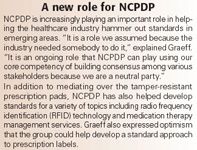This time pharmacists, doctors, and states are ready for tamper-resistant prescription pads
States issue guidelines for the April 1st implementation of Medicare's tamper-resistant prescription pad rule
Six months after it was initially set to go into effect, pharmacy organizations, physician groups, and state Medicaid directors attest that they are ready for the tamper-resistant prescription pad rule for the Medicaid program. "We are much better prepared," insists Hrant Jamgochian, director, Congressional and state relations at the American Pharmacists Association. But he cautioned, "There is still a lot of work to be done."
The tamper-resistant prescription pad rule mandates that all nonelectronic Medicaid prescriptions be written on tamper-resistant Rx pads to discourage fraud. Last September, days before the rule was set to go into effect, Congress pushed through legislation to delay implementation until April 1, 2008. Electronic prescriptions, faxed prescriptions, and prescriptions sent over the telephone are exempt from this requirement.
According to the legislation, beginning in April, nonelectronic Medicaid prescriptions must have at least one security feature. Beginning in October, Rxs will have to have at least three security features, including at least one feature from each of three categories established by the Centers for Medicare and Medicaid Services:

In January NCPDP convened a conference, bringing together major stakeholders including pharmacists, physicians, technology vendors, and state Medicaid officials. "We walked out with consensus on what kinds of security features fit in the three categories," Graeff said. More significantly, she noted, the group also focused on features that were technologically feasible, easy for pharmacists to identify, and inexpensive for physicians to purchase.
Two weeks after the meeting, NCPDP produced a final document outlining the suggested security features. According to Jamgochian, most states now specify what security features will be accepted, based primarily on the NCPDP recommendations.
With the guidance of NCPDP, states are cohering around a set of agreed-upon rules. For example, most states agree that a "void" pantograph on the pad is an accepted security feature. When a prescription is copied or scanned, the word "void" emerges in the background. Most states also require an Rx pad to have a list of its security features to help pharmacists quickly identify compliant pads and examine the security features.
As the states prepared for the April 1st implementation date, they have also undertaken an outreach effort to physicians, pharmacists, and consumers. "We are doing what we can on the educational side and in coordination with state Medicaid directors," Jamgochian told Drug Topics.
There still is significant variation from state to state. The South Carolina Medical Association, for example, has decided to endorse Standard Register as a preferrred vendor. California, for example, lists 11 accepted security features, while Texas has five and Maine has only four accepted features. To help pharmacists and physicians keep track of state regulations, the National Association of State Medicaid Directors has pledged to keep a clearinghouse for state requirements at http://www.nasmd.org/issues/TRPP.asp.
How PBMs Impede Pharmacists’ Ability to Perform Clinical Services | APhA 2025
March 31st 2025Antonio Ciaccia, President of 3 Axis Advisors, led a discussion on pharmacy benefit manager reform and how the inability to pass legislation has led to increased financial hardships in community pharmacy.